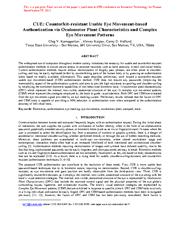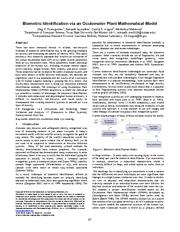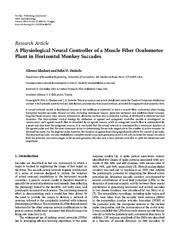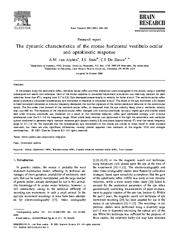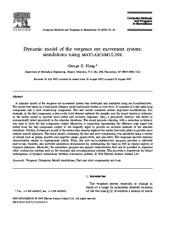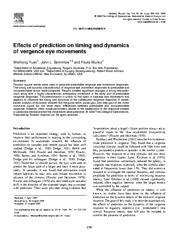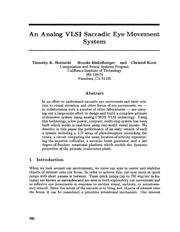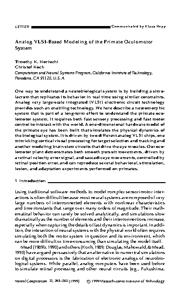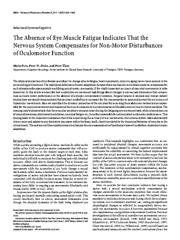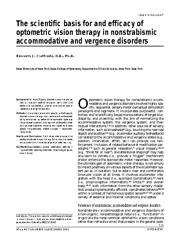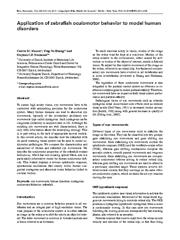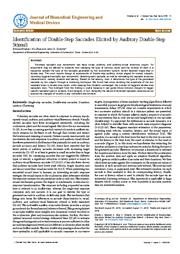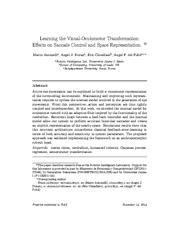A copy of this work was available on the public web and has been preserved in the Wayback Machine. The capture dates from 2016; you can also visit the original URL.
The file type is application/pdf.
Filters
CUE: counterfeit-resistant usable eye movement-based authentication via oculomotor plant characteristics and complex eye movement patterns
2012
Sensing Technologies for Global Health, Military Medicine, Disaster Response, and Environmental Monitoring II; and Biometric Technology for Human Identification IX
capabilities of two behavioral biometric traits: 1) oculomotor plant characteristics (OPC) which represent the internal, non-visible, anatomical structure of the eye; 2) complex eye movement patterns ...
Preliminary results indicate that the fusion of OPC and CEM traits is capable of providing a 30% reduction in authentication error when compared to the authentication accuracy of individual traits. ...
[11] proposed a method of biometric identification based on the anatomical characteristics of the oculomotor plant, using a jumping dot stimulus to facilitate OPC extraction. ...
doi:10.1117/12.919219
fatcat:lvonkieprfduhetdjhdn4pcq3e
Biometric identification via an oculomotor plant mathematical model
2010
Proceedings of the 2010 Symposium on Eye-Tracking Research & Applications - ETRA '10
The technique of using Oculomotor Plant Mathematical Model (OPMM) parameters to model the individual eye provides a number of advantages for biometric identification: it includes both behavioral and physiological ...
This paper presents a new biometric approach that involves an estimation of the unique oculomotor plant (OP) or eye globe muscle parameters from an eye movement trace. ...
A further advantage of the proposed method is its use of a dynamic oculomotor plant model consisting of the eye globe and extraocular muscles that is extremely difficult to counterfeit. ...
doi:10.1145/1743666.1743679
dblp:conf/etra/KomogortsevJAM10
fatcat:c7idlhntbvgnzlqa2lvajmkmga
A Physiological Neural Controller of a Muscle Fiber Oculomotor Plant in Horizontal Monkey Saccades
2014
ISRN Ophthalmology
A neural network model of biophysical neurons in the midbrain is presented to drive a muscle fiber oculomotor plant during horizontal monkey saccades. ...
It is concluded that the neural network is constrained by a minimum duration of the agonist pulse and that the most dominant factor in determining the saccade magnitude is the number of active neurons ...
Accordingly, the effect of the number of active neurons in controlling the saccade magnitude can be investigated in an adaptive control paradigm of the oculomotor plant. ...
doi:10.1155/2014/406210
pmid:24944832
pmcid:PMC4040203
fatcat:ae4ch5fcdbh2tgiz3whdxpgizy
The dynamic characteristics of the mouse horizontal vestibulo-ocular and optokinetic response
2001
Brain Research
The response of the vestibulo-ocular reflex changed with stimulus amplitude, having a higher gain and smaller phase lead when stimulus amplitude was increased. ...
The phase of the eye movement with respect to head movement advanced as stimulus frequency decreased, the familiar signature of the torsion pendulum behavior of the semicircular canals. ...
Placement of a search coil around 108 / s are reported [6, 18, 21] . may change the viscoelastic properties of the oculomotor plant in a way that would mimic a reduced time constant 4.1. ...
doi:10.1016/s0006-8993(00)03180-2
pmid:11164796
fatcat:r6yur6grynaslgl5y4nykdovom
A Dual-Mode Dynamic Model of the Vergence Eye Movement System
1986
IEEE Transactions on Biomedical Engineering
Moreover, the simulation program has general characteristics that can be modified to represent other oculomotor systems such as the versional and accommodation systems. ...
Further, Robinson's model of the extraocular muscles replaced the earlier 2nd-order plant to provide more realistic muscle dynamics. ...
the effect of plant dynamics. ...
doi:10.1109/tbme.1986.325868
pmid:3793122
fatcat:phptq346ujhs7ippc2tvxggibi
Dynamic model of the vergence eye movement system: simulations using matlab/simulink
1998
Computer Methods and Programs in Biomedicine
Moreover, the simulation program has general characteristics that can be modified to represent other oculomotor systems such as the versional and accommodation systems. ...
Further, Robinson's model of the extraocular muscles replaced the earlier 2nd-order plant to provide more realistic muscle dynamics. ...
the effect of plant dynamics. ...
doi:10.1016/s0169-2607(97)00048-5
pmid:9483368
fatcat:pdygohmbefczvludhld4na2lii
Effects of prediction on timing and dynamics of vergence eye movements
2000
Ophthalmic & physiological optics
The timing and dynamic characteristics of vergence eye movement responses to predictable and non-predictable stimuli were compared. ...
Results showed significant changes in timing characteristics along with a highly characteristic anticipatory movement in the early part of predictable vergence responses. ...
Acknowledgements This work was supported, in part, by a grant from the National Science Foundation IBN-9511655 ...
doi:10.1046/j.1475-1313.2000.00529.x
pmid:10962695
fatcat:jaaqmzlvzbc7lfh6s5wbcoybve
Effects of prediction on timing and dynamics of vergence eye movements
2000
Ophthalmic & physiological optics
The timing and dynamic characteristics of vergence eye movement responses to predictable and non-predictable stimuli were compared. ...
Results showed significant changes in timing characteristics along with a highly characteristic anticipatory movement in the early part of predictable vergence responses. ...
Acknowledgements This work was supported, in part, by a grant from the National Science Foundation IBN-9511655 ...
doi:10.1016/s0275-5408(99)00093-9
pmid:10962695
fatcat:vrplu2b4j5fxdp2oosc3cqjmia
An Analog VLSI Saccadic Eye Movement System
1993
Neural Information Processing Systems
the superior colliculus, a saccadic burst generator, and a one degree-of-freedom rotational platform which models the dynamic properties of the primate oculomotor plant. ...
effort to design and build a complete primate oculomotor system using analog CMOS VLSI technology. ...
The Oculomotor Plant The oculomotor plant is a one degree-of-freedom turntable which is driven by a pair of antagonistic-pulling motors. ...
dblp:conf/nips/HoriuchiBK93
fatcat:ijtiextwdba6rh627omwnmv52u
Analog VLSI-Based Modeling of the Primate Oculomotor System
1999
Neural Computation
Our oculomotor plant demonstrates both smooth pursuit movements, driven by a retinal velocity error signal, and saccadic eye movements, controlled by retinal position error, and can reproduce several behavioral ...
We here describe a neuromorphic system that is part of a long-term effort to understand the primate oculomotor system. ...
Acknowledgments We thank Brooks Bishofberger for mechanical design of the oculomotor system and fabrication of some of the dynamics simulation electronics, Tobi Delbrück for advice on photoreceptor circuit ...
doi:10.1162/089976699300016908
pmid:9950732
fatcat:yljsnhiwgzegrdl23ffo4fkcx4
The Absence of Eye Muscle Fatigue Indicates That the Nervous System Compensates for Non-Motor Disturbances of Oculomotor Function
2010
Journal of Neuroscience
Here we identified the dynamic properties of the eye plant by recording from abducens motoneurons responsible for the required movement and measured the muscle response to microstimulation of the abducens ...
brain itself, clearly unrelated to the dynamical behavior of muscles or the environment. ...
A two-way ANOVA analysis (the two factors being stimulus frequency and stimulation period) confirmed that across the 15 individual sessions, there was a significant main effect of stimulus frequency on ...
doi:10.1523/jneurosci.3901-10.2010
pmid:21106822
pmcid:PMC6633742
fatcat:pxitv255xjdezb3vlqrvx3d53u
The scientific basis for and efficacy of optometric vision therapy in nonstrabismic accommodative and vergence disorders
2002
Optometry - Journal of the American Optometric Association
In this article, the scientific basis for, and efficacy of, optometric vision therapy in such patients will be discussed. ...
Using bio-engineering models of the oculomotor system as the conceptual framework, emphasis will be focused on studies that used objective recording techniques to directly assess therapeutically related ...
Acknowledgments This document was funded in part by a grant from the Mountain States Congress of Optometry, in association with the American Optometric Association. I wish to thank Drs. ...
pmid:12498561
fatcat:cctw7b24vrcb7polsea36zka54
Application of zebrafish oculomotor behavior to model human disorders
2011
Reviews in the Neurosciences
We compare the characteristics and assessment of human and zebrafi sh eye movements. ...
We describe the oculomotor properties of the zebrafi sh mutant belladonna , which has non-crossing optical fi bers, and is a particularly informative model for human ocu lomotor deficits. ...
Acknowledgments Work in the author ' s laboratory is supported by the Swiss National Science Foundation (3100A0-1177892), The Zurich Center for Integrative Human Physiology and the European Commission ...
doi:10.1515/rns.2011.003
pmid:21615257
fatcat:i4kwize4qrgyxmpabeo53xqlny
Identification of Double-Step Saccades Elicited by Auditory Double-Step Stimuli
2016
Journal of Biomedical Engineering and Medical Devices
response characteristics, namely duration and latency. ...
An experiment may be defined to examine how changing the type of sensory inputs and the number of them in a sequence reveals the type of the saccade generated by the oculomotor system; herein deemed single-step ...
different oculomotor plant models and muscle fiber models. ...
doi:10.4172/2475-7586.1000120
fatcat:7odiqyvbsbd4pcbovwt3escsvq
Learning the visual–oculomotor transformation: Effects on saccade control and space representation
2015
Robotics and Autonomous Systems
Active eye movements can be exploited to build a visuomotor representation of the surrounding environment. ...
In this work, we encoded the internal model for oculomotor control with an adaptive filter inspired by the functionality of the cerebellum. ...
of the oculomotor system (plant) (Porrill and Dean, 2007) . ...
doi:10.1016/j.robot.2014.11.018
fatcat:ieo6lo7tyrgtlnztpjcrhyigeu
« Previous
Showing results 1 — 15 out of 524 results

